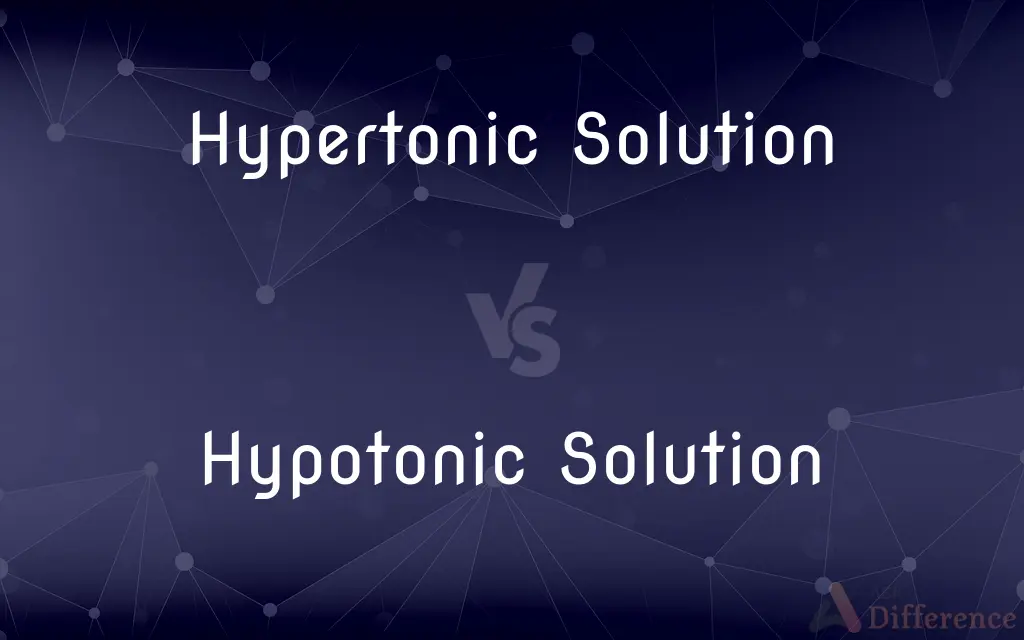Hypertonic Solution vs. Hypotonic Solution — What's the Difference?
By Tayyaba Rehman — Published on December 6, 2023
A Hypertonic Solution has a higher solute concentration than inside a cell, causing water to move out; a Hypotonic Solution has a lower solute concentration, causing water to move in.

Difference Between Hypertonic Solution and Hypotonic Solution
Table of Contents
ADVERTISEMENT
Key Differences
A Hypertonic Solution possesses a greater concentration of solutes outside the cell than inside, resulting in water moving out of the cell to balance the concentration. In contrast, a Hypotonic Solution has a lower concentration of solutes outside the cell, causing water to flow into the cell.
When a cell is immersed in a Hypertonic Solution, it loses water and may become shriveled. On the other hand, when a cell is in a Hypotonic Solution, it gains water, which might lead the cell to swell or even burst.
It's crucial in medical practices to understand the nature of the solution being used. A Hypertonic Solution might be employed to treat cellular swelling, while a Hypotonic Solution can rehydrate cells.
The effects of these solutions play a vital role in maintaining homeostasis in living organisms. Hypertonic Solutions can lead to dehydration in cells, while Hypotonic Solutions can ensure cells receive necessary hydration, but excessive water can be detrimental.
In the realm of osmosis, the Hypertonic Solution serves as a region of high solute concentration, causing water molecules to move out of the cell. Simultaneously, the Hypotonic Solution acts as a region of low solute concentration, prompting water molecules to move into the cell.
ADVERTISEMENT
Comparison Chart
Solute Concentration
Higher than inside the cell.
Lower than inside the cell.
Effect on Cells
Causes cells to lose water and shrivel.
Causes cells to gain water and swell.
Water Movement
Water moves out of the cell.
Water moves into the cell.
Usage in Medical Treatments
Often used to treat cellular swelling.
Used to rehydrate cells.
Relation to Osmosis
Region of high solute concentration.
Region of low solute concentration.
Compare with Definitions
Hypertonic Solution
A solution with elevated solute concentration.
To reduce the swelling, the nurse used a Hypertonic Solution.
Hypotonic Solution
A solution lesser in solute concentration than inside cells.
Hydration of cells is a common effect of a Hypotonic Solution.
Hypertonic Solution
A solution that leads to cellular dehydration.
He understood that the Hypertonic Solution would extract water from the cells.
Hypotonic Solution
A solution prompting water to enter cells.
When placed in a Hypotonic Solution, cells are at risk of bursting.
Hypertonic Solution
A medium prompting water to exit cells for osmotic balance.
Osmotic pressure is elevated in a Hypertonic Solution, driving water outward.
Hypotonic Solution
A solution leading to cellular hydration.
To hydrate the patient's cells, a Hypotonic Solution was administered.
Hypertonic Solution
A solution greater in solute concentration than inside cells.
Dehydration can be a result of prolonged exposure to a Hypertonic Solution.
Hypotonic Solution
A solution with diminished solute concentration.
The Hypotonic Solution caused the cells to expand as they absorbed water.
Hypertonic Solution
A solution causing water to move out of cells.
Cells immersed in a Hypertonic Solution typically shrivel.
Hypotonic Solution
A medium urging water to penetrate cells for osmotic balance.
In a Hypotonic Solution, osmotic pressure drives water into the cell.
Common Curiosities
What happens to cells in a Hypertonic Solution?
In a Hypertonic Solution, cells lose water and tend to shrivel.
How does a Hypotonic Solution affect cells?
In a Hypotonic Solution, cells gain water and may swell or burst.
How do plant cells respond differently than animal cells in a Hypotonic Solution?
Plant cells swell in a Hypotonic Solution but have a rigid cell wall that prevents bursting, unlike animal cells.
Why is understanding the nature of these solutions vital in medicine?
Because Hypertonic Solutions can treat cell swelling, and Hypotonic Solutions can rehydrate cells, affecting treatment outcomes.
Why do cells shrivel in a Hypertonic Solution?
Because water moves out of the cell to balance the high solute concentration outside.
Are there risks associated with using a Hypotonic Solution?
Yes, excessive use of a Hypotonic Solution can cause cells to burst.
Which solution is used to combat cellular dehydration?
A Hypotonic Solution is used to counteract cellular dehydration.
Do these solutions have an effect on osmotic balance?
Yes, Hypertonic Solutions drive water out, and Hypotonic Solutions drive water into cells, affecting osmotic balance.
Can prolonged exposure to a Hypertonic Solution harm cells?
Yes, prolonged exposure to a Hypertonic Solution can cause cells to dehydrate and become damaged.
How do these solutions maintain homeostasis in organisms?
Hypertonic Solutions can counteract cell swelling, and Hypotonic Solutions can counteract cell dehydration, balancing cellular environments.
What is the primary movement of water in a Hypotonic Solution?
In a Hypotonic Solution, water primarily moves into the cell.
How do red blood cells react in a Hypotonic Solution?
In a Hypotonic Solution, red blood cells can swell and potentially lyse or burst.
Which solution can lead to cellular dehydration?
A Hypertonic Solution can lead to cellular dehydration.
Can these solutions affect osmotic pressure?
Yes, Hypertonic Solutions increase and Hypotonic Solutions decrease osmotic pressure.
What’s the key difference in solute concentration between the two?
Hypertonic Solutions have higher solute concentrations than cells, while Hypotonic Solutions have lower solute concentrations.
Share Your Discovery

Previous Comparison
UCSD vs. SDSU
Next Comparison
USB 2.0 vs. USB 3.0Author Spotlight
Written by
Tayyaba RehmanTayyaba Rehman is a distinguished writer, currently serving as a primary contributor to askdifference.com. As a researcher in semantics and etymology, Tayyaba's passion for the complexity of languages and their distinctions has found a perfect home on the platform. Tayyaba delves into the intricacies of language, distinguishing between commonly confused words and phrases, thereby providing clarity for readers worldwide.
















































